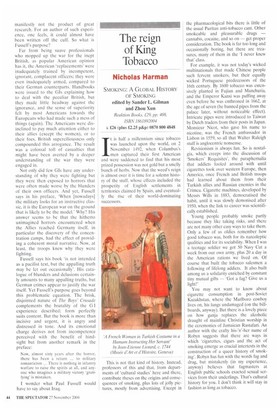The reign of King Tobacco
Nicholas Harman
SMOKING: A GLOBAL HISTORY OF SMOKING edited by Sander L. Gilman and Zhou Xun Reaktion Books; £29, pp. 408, ISBN 1861892004 & £26 (plus £2.25 p&p) 0870 800 4848 It is half a millennium since tobacco was launched upon the world, on 2 November 1492, when Columbus's men captured their first American and were saddened to find that his most prized possession was not gold but a smelly bunch of herbs. Now that the weed's reign is almost over it is time for a solemn history of the stuff, whose effects included the prosperity of English settlements in territories claimed by Spain, and eventually the rise of their world-dominating successors.
'A French Woman in Turkish Costume in a Hamam Instructing Her Servant' by Jean-Etienne Liotard, c. 1744 (Musee d'Arl et d'Histoire, Geneva) This is not that kind of history. Instead, professors of this and that, from departments of 'cultural studies' here and there, contribute theses on the origins and consequences of smoking, plus lots of jolly pictures, mostly from advertising. Except in the pharmacological bits there is little of the usual Puritan anti-tobacco cant. Other smokeable and pleasurable drugs — cannabis, cocaine, and so on — get proper consideration. The book is far too long and occasionally boring, but there are treasures, many of them in the 'I never knew that' class.
For example, it was not today's wicked multinationals that made Chinese people such fervent smokers, hut their equally wicked Portuguese predecessors of the 16th century. By 1600 tobacco was extensively planted in Fujian and Manchuria, and the Emperor Kanxi was puffing away even before he was enthroned in 1662, at the age of seven (he banned pipes from the palace later, without noticeable effect). Intricate pipes were introduced to Taiwan by Dutch traders from their posts in Japan. Monsieur Nicot, who gave his name to nicotine, was the French ambassador in Lisbon in 1559, so all that Walter Raleigh stuff is anglocentric nonsense.
Revisionism is always fun. So is nostalgia, which creeps into the discussion of 'Smokers' Requisites', the paraphernalia that addicts fooled around with until cigarettes took over western Europe, then America, once French and British troops had learned about them from their Turkish allies and Russian enemies in the Crimea. Cigarette machines, developed by Messrs Wills in 1883, democratised the habit, until it was slowly demonised after 1950, when the link to cancer was scientifically established.
Young people probably smoke partly because they like taking risks, and there are not many other easy ways to take them. Only a few of us oldies remember how good tobacco was, both for its narcoleptic qualities and for its sociability. When I was a teenage soldier we got 50 Navy Cut a week from our own army, plus 20 a day in the American rations we lived on. Of course that built the tobacco salesmen a following of lifelong addicts. It also built among us a solidarity enriched by constant tiny mutual gifts — 'Got a fag? Give us a light!'
You may not want to know about cigarette consumption in post-Soviet Kazakhstan, where the Marlboro cowboy lives on, his lungs undamaged (on the billboards, anyway). But there is a lovely piece on how ganja replaces the alcoholic draught of mainline Christian worship in the ceremonies of Jamaican Rastafari. An author with the crafty his-'n'-her name of Robyn suggests that there are ways in which 'cigarettes, cigars and the act of smoking emerge as crucial intertexts in the construction of a queer history of smoking'. Robyn has fun with the words fag and drag, but mistakenly (in my experience, anyway) believes that fagmasters at English public schools exacted sexual services from their underlings. That's cultural history for you. I don't think it will stay in fashion as long as tobacco.


















































































 Previous page
Previous page